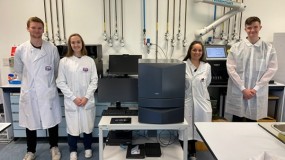The most advanced, transportable and user-friendly LSC on the market
The Hidex 300 SL is a revolutionary instrument which incorporates the most advanced technology available, triple-to-double coincidence ratio (TDCR) counting. TDCR utilizes a unique design with three photomultiplier detectors aligned 120 degrees from each other, which offers superior efficiency and counting results for both advanced research and environmental work.
The 300 SL has a modern and compact design measuring half the size and weight of some of its long standing rivals. It is therefore much easier to fit it into smaller, more space conscious laboratories, such as transporting in research vessels or mobile labs.
Compatible with Windows
Hidex is the only manufacturer of liquid scintillation counters whose software is fully compatible with Windows 11, Microsoft’s latest major release. Hidex’s MikroWin version 5.62 can be run on any external desktop, whereas other manufacturers use internal computers that are integrated into the liquid scintillation counter itself.
This can present problems if there is a fault with the internal computer, as it prevents the user from operating the instrument as well. Being able to use an external desktop to manage your instruments allows MikroWin software to be easily updated with new releases and is compatible with Microsoft’s latest security features introduced in Windows 11.
MikroWin features an easy-to-use graphical interface and advanced data reduction capabilities. An unlimited number of protocols, easy export to Excel, custom calculations, and quench curves are all included.
Hidex 300 SL existing users
Click the tabs below to learn more about our customers and their applications for the Hidex 300 SL.
Nuclear
Environmental
Documents
-
Hidex-300-SL-and-600-SL-Brochure-US-Version-1.4
Download (3.85 MB)
Catalogues
-
Monitoring-and-Analytical-Equipment-EU-Version-1.3
Download (28.21 MB)










